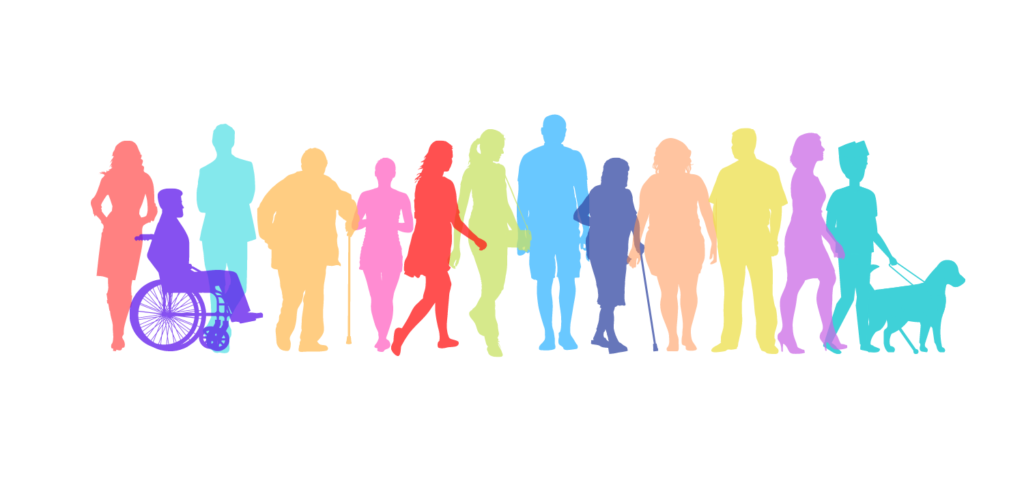Team buildings? Nope, that’s not a typo. We’re diving into what inclusive design is, why it’s important, and how to utilize it to create equitable workplaces, leveraging your building to give your organization a competitive advantage in the marketplace.
What exactly is inclusive design?
Diversity and inclusion have been hot topics of recent years, and the momentum around them is only getting stronger. Many business owners are wondering how to kick-start initiatives to become more diverse and inclusive. But what does that mean in terms of the physical space around us?
Inclusive design considers the full spectrum of both visible and invisible diversity traits. It then creates a user experience where all persons feel equally involved and supported in all areas.
An inclusive design looks at the mix of characteristics that make us all us. Examples of these characteristics are visible things such as gender, race, age, physical ability, and body type and invisible things such as sexual orientation, religion, education, experience, and socioeconomic status. From there, the design team takes an intentional step in crafting a comfortable physical work environment that welcomes and supports all occupants in all areas.
Why is any of this important?
Besides being the right thing to do, inclusive design can give your company an edge in its respective marketplace. Merely having an organizational focus on diversity and supporting that message with an inclusive plan, you’re increasing the available talent pool exponentially. From there, the domino effect takes action. A larger talent pool gives you access to more employee experiences, different perspectives, and creative ideas. Those ideas lead to more innovation and increased profitability. Don’t believe me? According to an article from Forbes.com, diverse companies attain 19% higher revenue than monolithic companies due to more significant innovation. All of this generates greater job satisfaction, more substantial levels of engagement, and higher retention rates. You can’t lose.
How to integrate inclusive design
We’ve discussed the what and the why, so how can you make it all come together?
This style of design doesn’t happen by accident. It takes intention and a thoughtful yet subtle approach to the final result. You want to create an inclusive environment but not do it in a way that singles people out or calls attention to differences. If there is any doubt, check the idea against the universal design principles.
UniversalDesign.ie is a fantastic resource that explains the history of The 7 Principles of Universal Design and how they guide environment, product, and communication design. In a nutshell, any product or space should be easily accessed, understood, and used to the greatest possible extent in the most natural manner possible and apply to the broadest range of situations. The product or space use must also occur without the need to adapt, modify, require special devices or special solutions by anyone of any age, size, or having any particular physical, sensory, mental health, or intellectual ability or disability.
Below are examples that, with minimal effort, integrate into your workspace at any time.
If you’re taking a one-size-fits-all approach to your office furniture and space design, you may be inadvertently alienating part of your workforce. A simple solution, also a favorite of mine, is zone-based design. With zoning, you accommodate a wide range of occupant needs regarding visual, acoustic, thermal, and task-based comfort. Some of the primary zones are Focus, Collaboration, Restoration, Privacy, and Work, to name a few.
In addition to zoning, you can go a few steps farther with specific products and design features to support your particular areas, such as:
SMART technologies help occupants adjust their ambient environment to fit their individual preferences, such as lighting, heating, and glare.
Ergonomic assessments, tools, and user education make a significant impact on occupant comfort and accessibility.
Active furnishings are another great way to support inclusive workplaces. Integrating height-adjustable furniture accommodates a wide variety of occupants and helps promote movement throughout the day. Implementing a few treadmill desks or bicycle desks promotes light physical activity and helps focus and attention.
Utilize various textures and colors on walls and furniture as cues for the visually impaired.
See, implementing inclusive design doesn’t have to be crazy complicated, and every organization can benefit from it. My challenge to you? Find one way to incorporate a more inclusive design element into your current workspace and see how it impacts your people in the next few months.

Courtnay Bradley WELL AP is founder and chief purpose officer at Trilogie and host of The Up/Down Podcast and Trilogie’s Table Talk live stream series. Her passion for people fuels her obsession with helping companies design and furnish work environments that truly inspire and engage employees. In 2009 she started Trilogie with the sole purpose of creating kick-ass workspaces that help organizations thrive.

